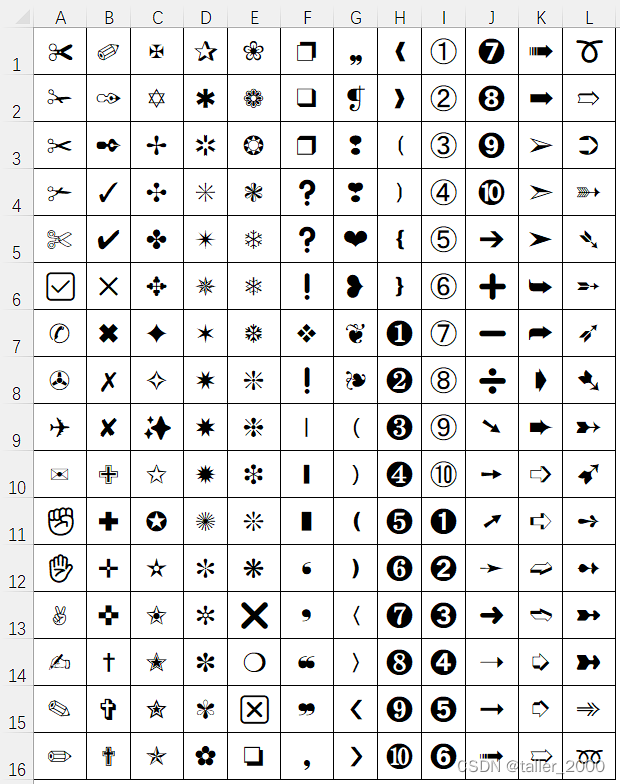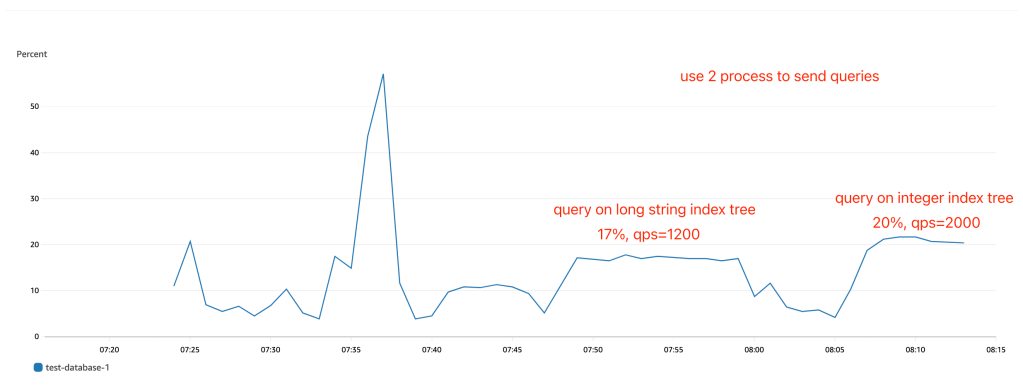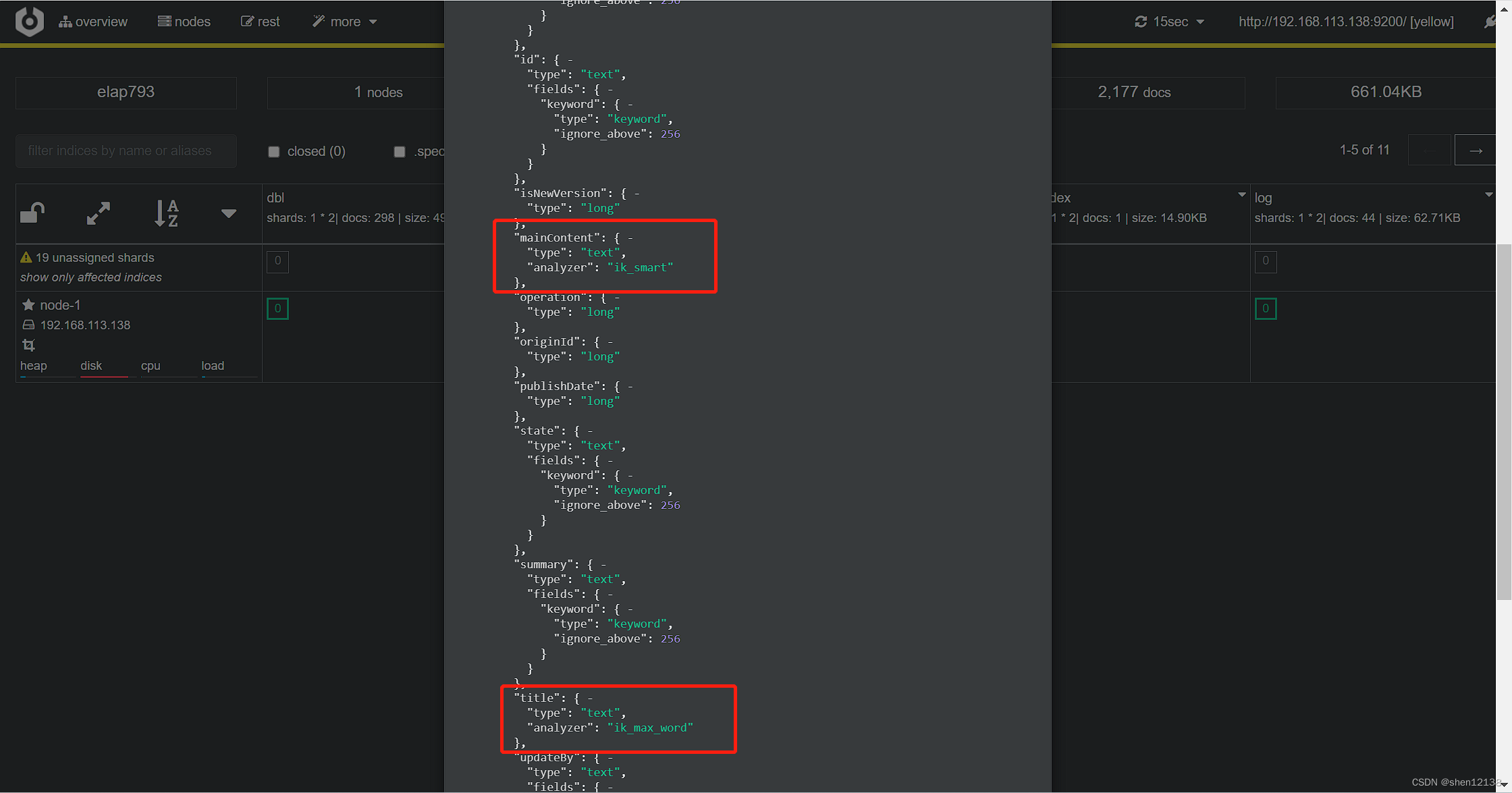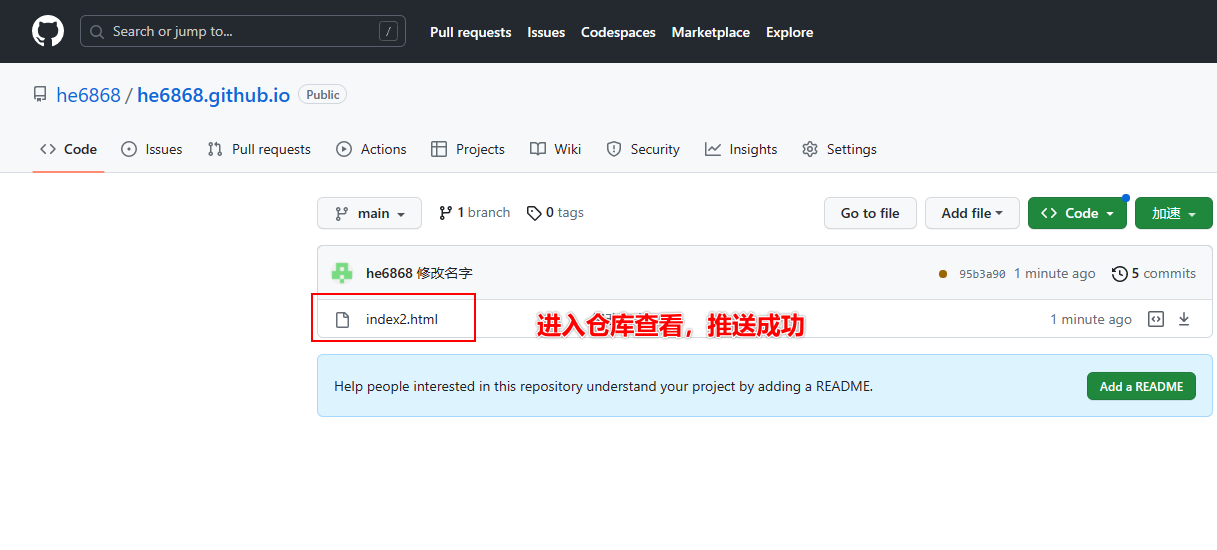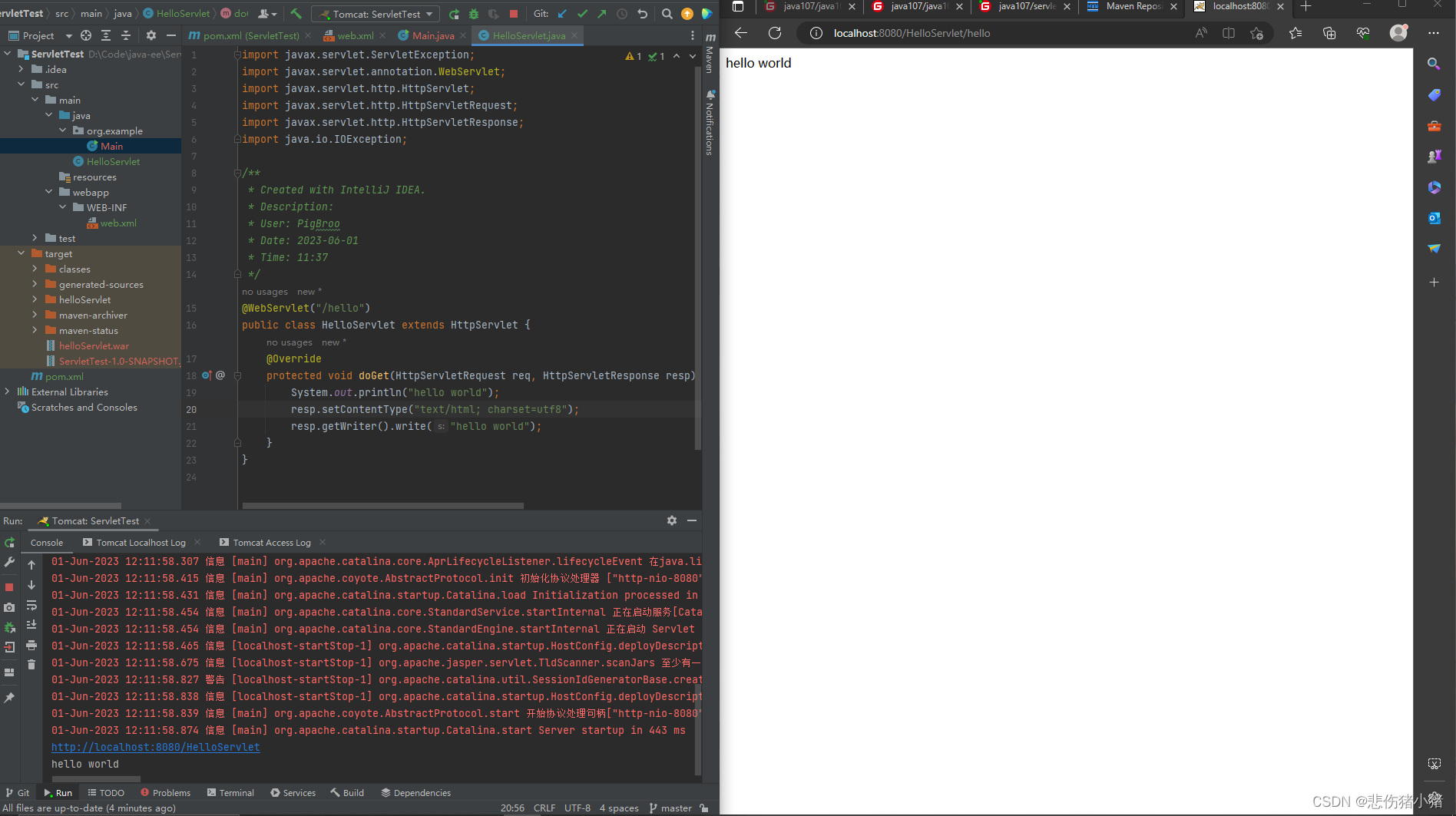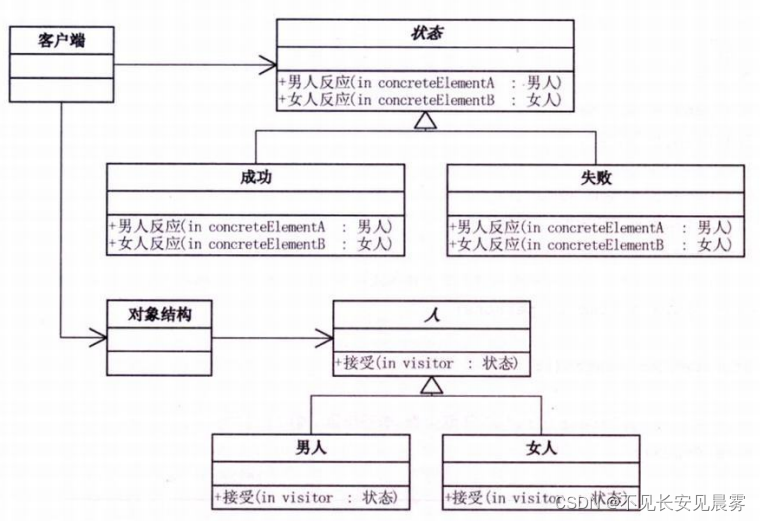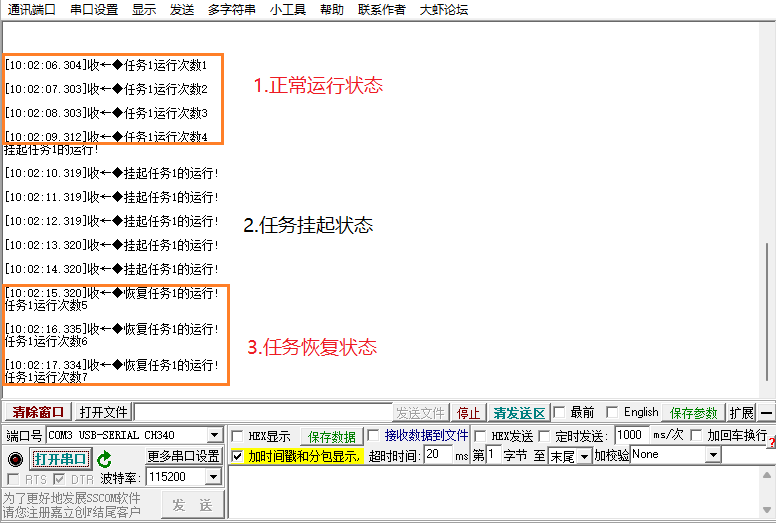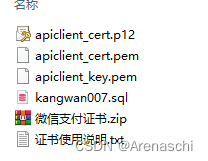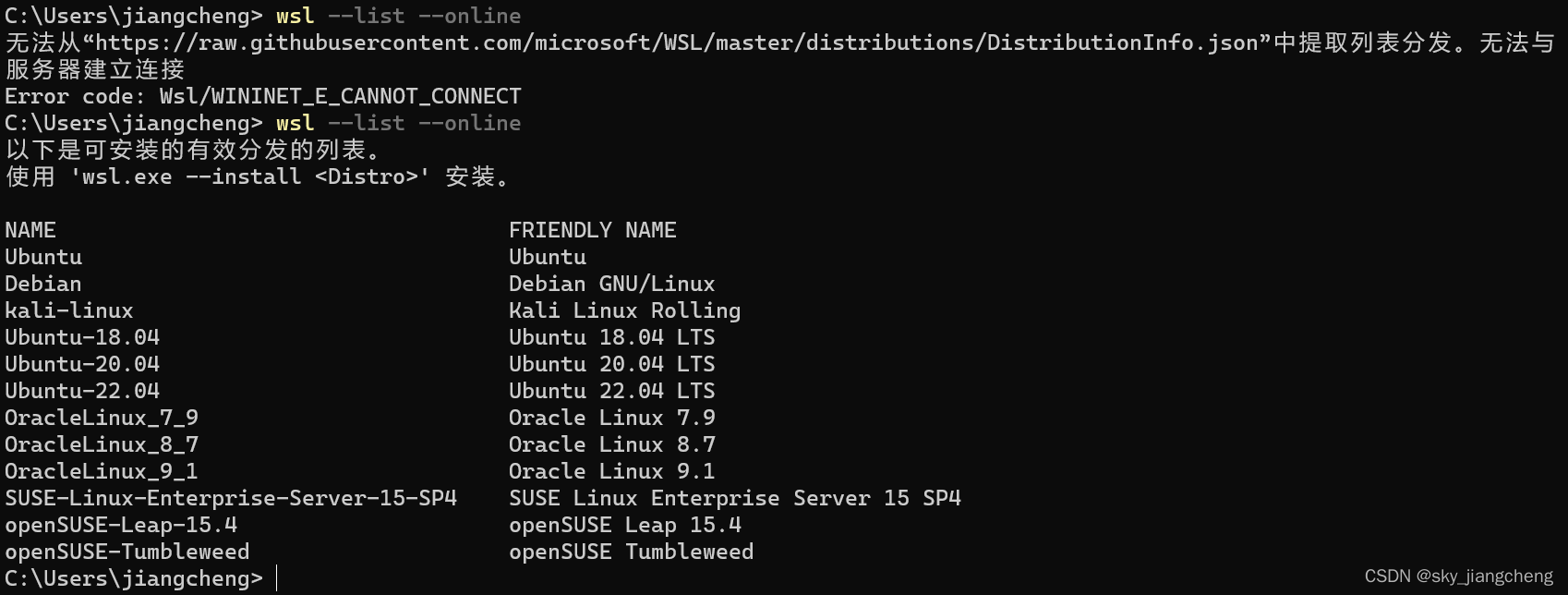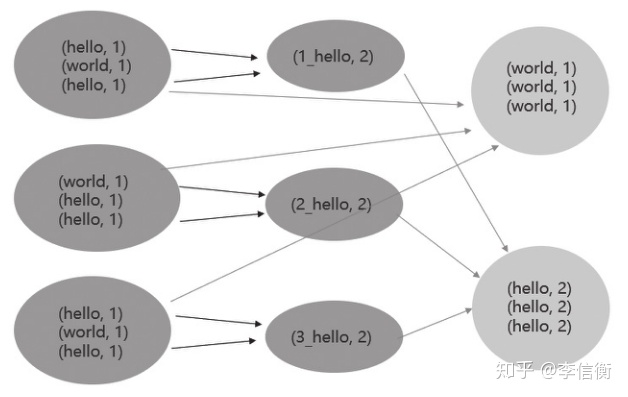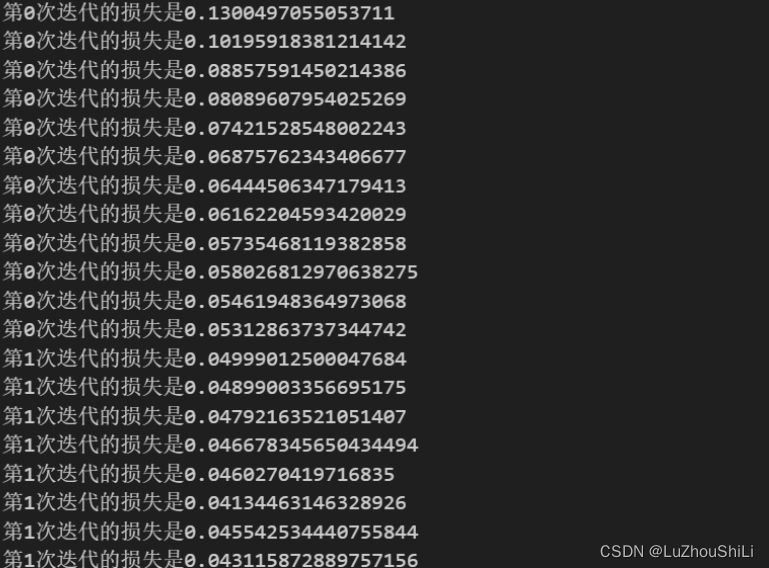目录
1、View的绘制流程
2、自定义ViewGroup构造函数的作用
3、onMeasure 方法
3.1、View的度量方式
3.2、onMeasure方法参数的介绍
3.3、自定义ViewGroup onMeasure 方法的实现
4、onLayout方法
5、onDraw方法
6、自定义View的生命周期
7、自定义流式布局的实现
扩展:
1、View的绘制流程
从Activity启动开始,了解View的绘制流程。
图1:Activity启动的流程。
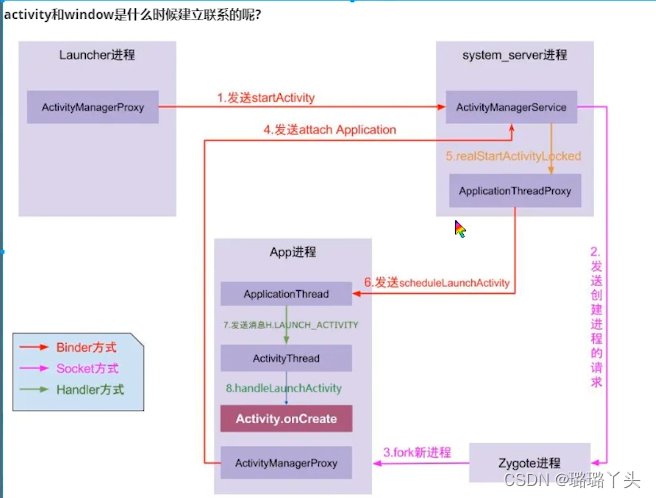
图2:Activity启动的调用流程
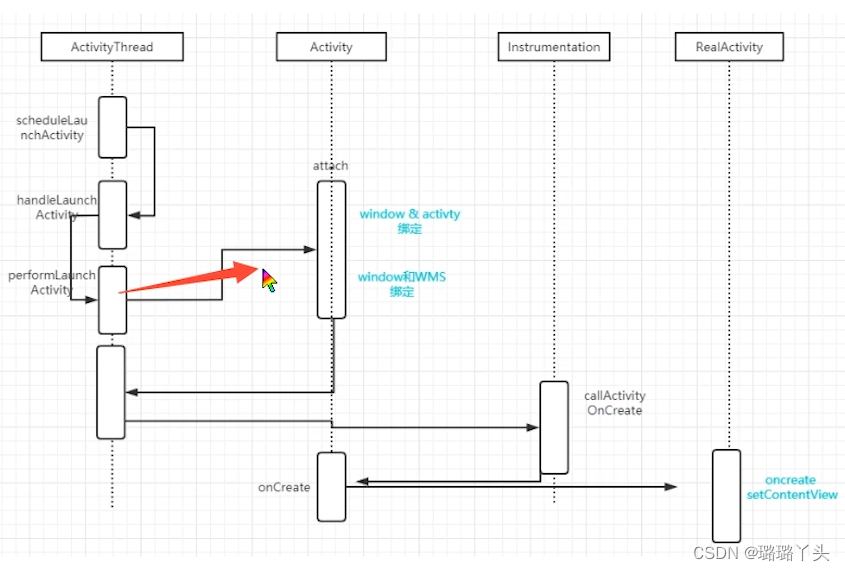
图3:显示了View与Window的逻辑结构。
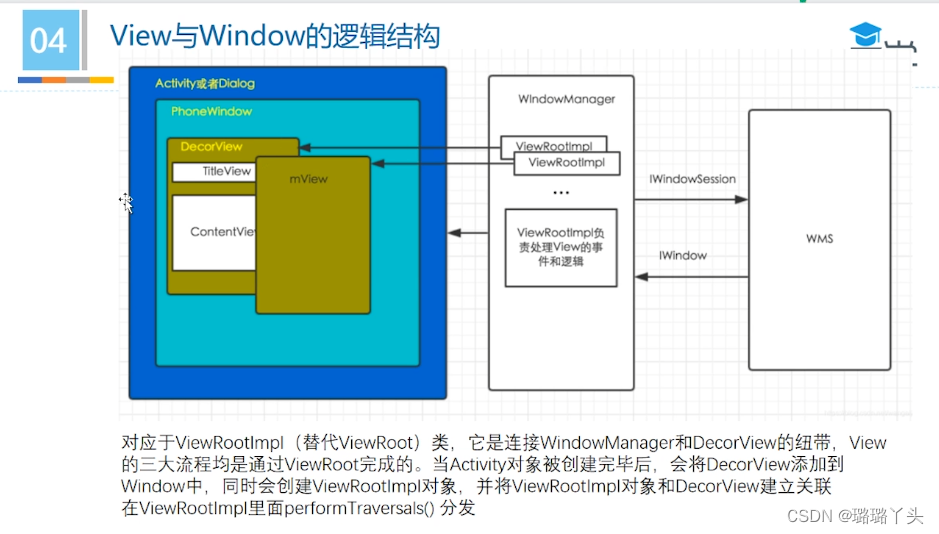
图3中的ViewRootImpl是在图2中的Activity的attach中生成的,是在Activity的onCreate生命周期之前,ViewRootImpl负责处理View 的事件和逻辑。
图4:ViewRootImpl的方法的调用流程

通过ViewRootImpl的performTraversals方法看出View的绘制流程 mearsure、layout、draw,分别对应View及ViewGroup的onMeasure、onLayout和onDraw方法。
图5:Activity在onCreate时使用setContentView 给Activity设置具体的ContentView。
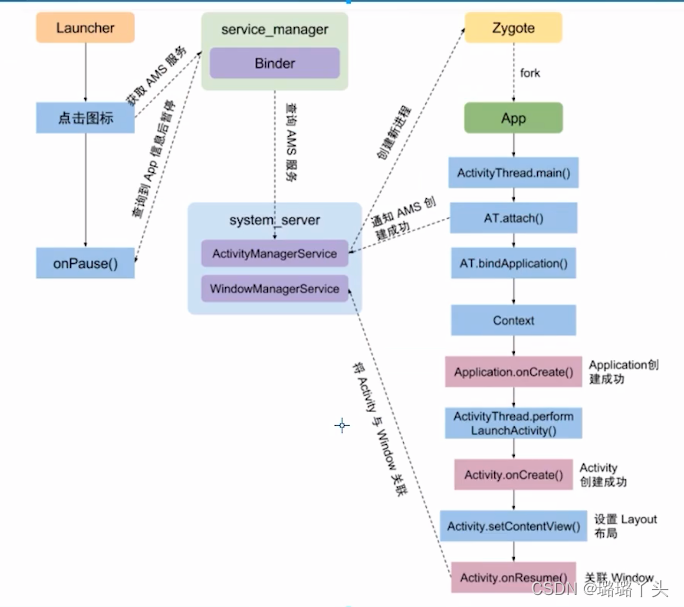
2、自定义ViewGroup构造函数的作用
构造函数用于创建对象,自定义View或ViewGroup会有三个不同用途的构造函数,分别用于
new Object()创建对象、xml解析生成对象和自定义。
/**
* 通过 new FlowLayout() 代码创建
* @param context
*/
public FlowLayout(Context context) {
super(context);
}
/**
* 通过xml解析创建
* @param context
* @param attrs
*/
public FlowLayout(Context context, AttributeSet attrs) {
super(context, attrs);
}
/**
* 自定义View 默认的属性以及自定义的属性
* @param context
* @param attrs
* @param defStyleAttr
*/
public FlowLayout(Context context, AttributeSet attrs, int defStyleAttr) {
super(context, attrs, defStyleAttr);
}3、onMeasure 方法
可参照LinearLayout或其他布局代码中onMeasure 的具体实现。
3.1、View的度量方式

View的层级结构如上图,在measure时,采用深度递归自上而下进行遍历,在ViewGroup中触发子View的度量。
3.2、onMeasure方法参数的介绍
@Override
protected void onMeasure(int widthMeasureSpec, int heightMeasureSpec) {
super.onMeasure(widthMeasureSpec, heightMeasureSpec);
}
onMeasure方法的参数有2个,分别是widthMeasureSpec和heightMeasureSpec,两个参数分别是
父布局根据父布局的宽高、父布局的padding、当前控件的layout_width或layout_height属性值、当前控件的margin属性值生成的包含width和height相关的mode以及宽高值。
以ViewGroup的width为例,layout_width有三种数值,match_parent、wrap_content和固定值。
当layout_width为match_parent时,分配给的宽度是父布局的宽度。
当layout_width为wrap_content时,因还未知具体需要多大的宽度,所以分配的宽度是父布局的宽度。
当layout_width为固定值时,分配的宽度是固定值。
综上,度量最终计算的宽高只会比参数中给定的宽高小或者相等。
3.3、自定义ViewGroup onMeasure 方法的实现
在自定义ViewGroup时需要实现onMeasure方法,否则layout_width和layout_height属性无效,该ViewGroup的宽高为父控件的宽高。
在重写onMeasure方法时,该方法需要实现的功能如下:
-
度量子View(深度递归,因为ViewGroup不是叶子节点,一定要度量子View的宽高)
-
根据子View度量后的宽高计算ViewGroup的宽高
注意:
-
在度量子View的宽高时要考虑ViewGroup的padding和子View的margin值。
-
在计算ViewGroup的宽高时,要使用子View度量后的宽高,(ViewGroup分配给子View的宽高可能会大,需要子View执行onMeasure方法后确定自己的宽高)
-
在计算ViewGroup的宽高时要加入ViewGroup的padding值。
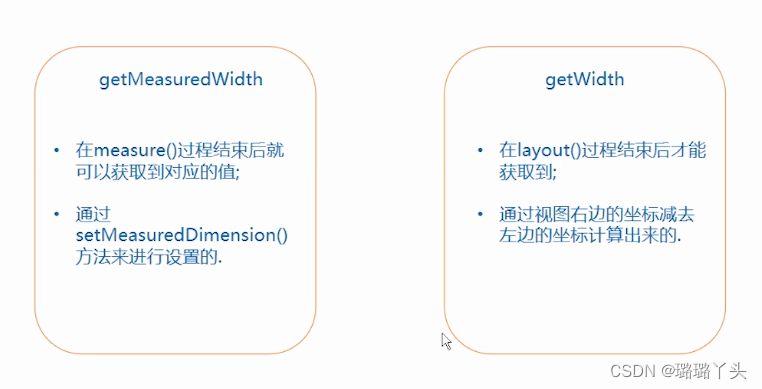
4、onLayout方法
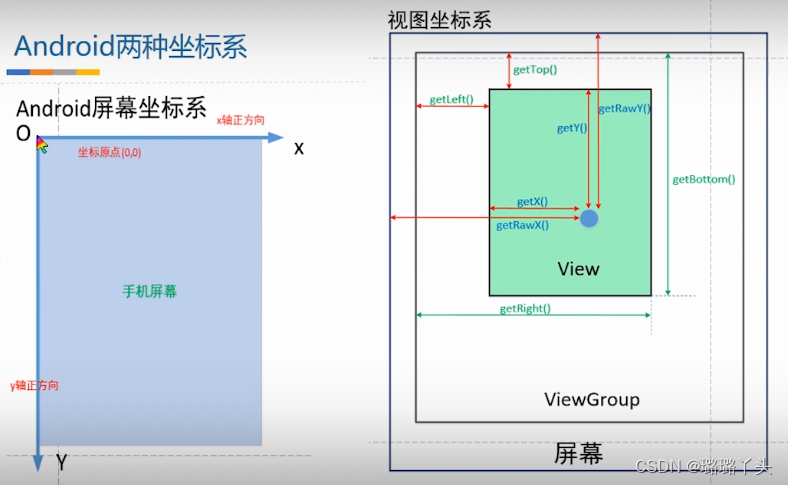
在onLayout方法中使用相对父控件的相对布局,而不是相对Android屏幕坐标系的绝对布局,在实现onLayout时只考虑与父控件的关系即可,最终在View绘制时,会将相对位置转换为绝对位置,此工作是由WMS来实现的。
注意:
-
在自定义ViewGroup的 onLayout中,需考虑ViewGroup的padding和子View的margin值
-
在自定义View中不用实现onLayout。
5、onDraw方法
ViewGroup的作用在于布局子View,如果需要边框和背景的绘制,在onDraw中实现,如不需要,可不实现。
6、自定义View的生命周期

View的度量、布局和绘制会有多次,但是View的初始化只有一次。
7、自定义流式布局的实现
package com.liluj.androidui.custom;
import static com.scwang.smartrefresh.layout.util.SmartUtil.dp2px;
import android.content.Context;
import android.util.AttributeSet;
import android.view.View;
import android.view.ViewGroup;
import com.liluj.androidui.utils.UnitConvertUtils;
import java.util.ArrayList;
import java.util.List;
/**
* 自定义流式布局
*/
public class FlowLayout extends ViewGroup {
//水平间隔
private int horizontalSpace = dp2px(20);
//垂直间隔
private int veticalSpace = dp2px(20);
private List<List<View>> lineViewList; //记录每行的View
private List<Integer> heightList; //记录每列的高度。
/**
* 通过 new FlowLayout() 代码创建
* @param context
*/
public FlowLayout(Context context) {
super(context);
}
/**
* 通过xml解析创建
* @param context
* @param attrs
*/
public FlowLayout(Context context, AttributeSet attrs) {
super(context, attrs);
}
/**
* 自定义View 默认的属性以及自定义的属性
* @param context
* @param attrs
* @param defStyleAttr
*/
public FlowLayout(Context context, AttributeSet attrs, int defStyleAttr) {
super(context, attrs, defStyleAttr);
}
public FlowLayout(Context context, AttributeSet attrs, int defStyleAttr, int defStyleRes) {
super(context, attrs, defStyleAttr, defStyleRes);
}
private void initMeasure() {
/**
* 此两个参数是为了给Layout布局用的,界面不只绘制一次,会重新绘制,所以在每次执行onMeasure时要重新初始化,而不是在创建FlowLayout时初始化
*/
lineViewList = new ArrayList();
heightList = new ArrayList<>();
}
/**
* 依据子View的宽高 确定自己的宽高
* 注意:
* 1、margin值在父控件中处理
* 1.1 当前ViewGroup的margin值在父控件已处理
* 1.2 在度量和布局子View时要考虑margin值,否则子View的margin属性无用(此例子没处理子View的margin值)
* 2、padding值包含在ViewGroup以及View的宽高
* 2.1 在ViewGroup和View的 onMeasure、onLayout、onDraw时要考虑自身的padding值
* @param widthMeasureSpec horizontal space requirements as imposed by the parent.
* The requirements are encoded with
* {@link android.view.View.MeasureSpec}.
* @param heightMeasureSpec vertical space requirements as imposed by the parent.
* The requirements are encoded with
* {@link android.view.View.MeasureSpec}.
*
*/
@Override
protected void onMeasure(int widthMeasureSpec, int heightMeasureSpec) {
super.onMeasure(widthMeasureSpec, heightMeasureSpec);
initMeasure();
int count = getChildCount();
List<View> lineView = new ArrayList<>();
int lineUsedWidth = 0; //当前行已使用的宽度
int lineHeight = 0; //当前行的高度
int mWidth = 0; //view的宽度
int mHeight = 0; //view的高度
/**
* 父控件根据自己的宽高以及当前View的LayoutParam属性(宽、高、margin)分配给当前View的宽高,固定值就是固定值,
* match_parent和wrap_content为父控件的宽度,
*/
int maxWidth = MeasureSpec.getSize(widthMeasureSpec);
//子View可使用的最大宽度,需减去ViewGroup的paddingLeft和paddingRight
int childrenCanUseWidth = maxWidth - getPaddingLeft()-getPaddingRight();
int maxHeight = MeasureSpec.getSize(heightMeasureSpec);
/**
* 度量子View并计算ViewGroup属性为wrap_content时实际的宽高
*/
for(int i = 0;i<count;i++){
View view = getChildAt(i);
/**
* 根据当前View的MeasureSpec属性、padding值和子View的LayoutParams值(android:layout_width和android:layout_height的属性值)来给子View分配空间
*/
int measureSpecWidth = getChildMeasureSpec(widthMeasureSpec,getPaddingLeft()+getPaddingRight(),view.getLayoutParams().width);
int measureSpecHeight = getChildMeasureSpec(heightMeasureSpec,getPaddingTop()+getPaddingBottom(),view.getLayoutParams().height);
/**
* 触发子View度量自己的空间,子View度量自己的大小后校正子View的大小
*/
view.measure(measureSpecWidth,measureSpecHeight);
int measuredWidth = view.getMeasuredWidth();
int measuredHeight = view.getMeasuredHeight();
//换行
if(lineUsedWidth + measuredWidth > childrenCanUseWidth){
lineViewList.add(lineView);
heightList.add(lineHeight);
mWidth = Math.max(mWidth,lineUsedWidth);
mHeight = mHeight + lineHeight + veticalSpace;
lineUsedWidth = 0;
lineHeight = 0;
lineView = new ArrayList<>();
}
lineView.add(view);
lineUsedWidth = lineUsedWidth + measuredWidth + horizontalSpace;
lineHeight = Math.max(lineHeight, measuredHeight);
/**
* 添加上最后一行的宽高
*/
if(i == count -1){
lineViewList.add(lineView);
heightList.add(lineHeight);
mWidth = Math.max(mWidth,lineUsedWidth);
mHeight = mHeight + lineHeight;
}
}
//ViewGroup的宽高加上padding值
mWidth = mWidth+getPaddingLeft()+getPaddingRight();
mHeight = mHeight+getPaddingTop()+getPaddingBottom();
/**
* 获取当前View 宽高的mode
*/
int widthMode = MeasureSpec.getMode(widthMeasureSpec);
int heightMode = MeasureSpec.getMode(heightMeasureSpec);
/**
* 当View的宽高为固定值时,使用固定值,此处固定值只会比按照wrap_content计算出来的值大,不会小,与父控件分配给当前View的宽高值有关。
* 可参见ViewGroup的getChildMeasureSpec方法
*/
int realWidth = (widthMode == MeasureSpec.EXACTLY) ? maxWidth:mWidth;
int realHeight = (heightMode == MeasureSpec.EXACTLY) ? maxHeight:mHeight;
setMeasuredDimension(realWidth,realHeight);
}
/**
* 布局子View,布局子View时使用相对坐标(相对父View进行布局)而不是绝对坐标(Window坐标系)
* @param changed This is a new size or position for this view
* @param l Left position, relative to parent
* @param t Top position, relative to parent
* @param r Right position, relative to parent
* @param b Bottom position, relative to parent
*/
@Override
protected void onLayout(boolean changed, int l, int t, int r, int b) {
int curL = getPaddingLeft();
int curT = getPaddingTop();
for(int i = 0;i< lineViewList.size();i++){
List<View> lineView = lineViewList.get(i);
for(int j = 0;j<lineView.size();j++){
View view = lineView.get(j);
int left = curL;
int top = curT;
int right = curL + view.getMeasuredWidth();
int bottom = curT + view.getMeasuredHeight();
view.layout(left,top,right,bottom);
curL = right + horizontalSpace;
}
curL = getPaddingLeft();
curT = curT + heightList.get(i)+veticalSpace;
}
}
}
效果图:
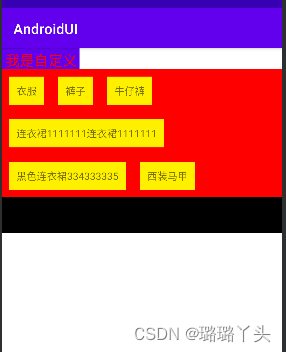
扩展:
- 将xml解析为UI
例如:LinearLayout标签解析为LinearLayout 对象,layout_width,layout_height、layout_weight会生成对应的LayoutParam。
MeasureSpec用于表示View以及ViewGroup的宽高
xml解析采用反射实现。
